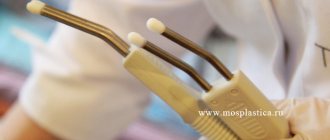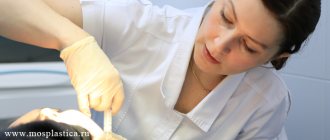Indications Contraindications Preparation Types of operations Recovery
Many patients turn to a plastic surgeon when they need frontal surgery of the forehead or brow ridges. This term refers to a whole range of different intervention methods used by plastic surgeons to change the shape and eliminate various cosmetic defects in the brow ridge or frontal area. Forehead reduction surgery allows you to correct facial asymmetry and increase the projection of the frontal tuberosities.
Indications for forehead and eyebrow plastic surgery
The key indication for frontoplasty is the patient’s desire; if he is not satisfied with the appearance of the forehead and face as a whole, this brings him psychological discomfort and creates complexes. Indications for intervention:
- the presence of asymmetry of the forehead in relation to the rest of the face;
- deformations in the forehead, undesirable defects of bone structures;
- very large or too low forehead;
- post-traumatic or congenital defects in the area of the frontal bone.
In addition to performing forehead frontoplasty, the doctor can also correct soft tissues, eliminating wrinkles, which gives a rejuvenating effect.
Post-procedure care and recommendations
After plastic surgery, a person needs about 3-4 weeks to recover. In the case of the injection method, it is enough not to touch the puncture sites with your hands, not to take hot baths and not to be in the sun. Recovery occurs within a week.
During surgery there will be swelling and hematomas, but this will all go away in a couple of weeks. It is at this time that the stitches are removed. In certain parts of the head, sensitivity disappears, which appears after 1-3 months. For quick rehabilitation, you need to take painkillers and anti-inflammatory pills.
Contraindications to forehead reduction and plastic surgery
Before performing frontoplasty, a full examination and consultation with a plastic surgeon is necessary to exclude possible contraindications. This is important to avoid complications and irreversible changes after the intervention. Thus, the operation is not performed if:
- this is a patient under 18 years of age;
- there are chronic diseases in the stage of exacerbation or decompensation;
- HIV infection or oncology is detected;
- Frontal sinusitis (inflammation of the frontal sinus) was detected.
If the development of the facial skeleton is not yet complete, there are skin problems in the operation area, serious illnesses have worsened, there are signs of ARVI or general malaise; during pregnancy and lactation, the operation will be temporarily postponed.
Who is this procedure contraindicated for?
- persons under 18 years of age;
- patients suffering from cancer;
- patients who experience inflammatory processes in the tissues involved in the operation;
- people who have impaired blood clotting, as well as those who take medications that reduce it;
- patients with diabetes mellitus, as well as various infectious diseases.
Before you decide to have surgery, you will need to meet with the surgeon (if necessary, there may be several such conversations). Discuss with your doctor all possible options for carrying out the procedure, study in detail the theoretical material that the specialist will recommend to you. Talk to people who have already had positive experiences with similar plastic interventions. Complete all necessary examinations and arrange for a simulation.
Preparation
After consultation to determine the price of frontal surgery of the forehead or brow ridges, preoperative preparation is necessary. In addition to all tests, consultations with a therapist, ENT doctor and anesthesiologist, it is necessary to perform radiographs in lateral and direct projections. They help the surgeon evaluate the shape of the sinuses, their true size, the thickness of the bony septa and the location of the anatomical structures.
The peculiarities of frontoplasty are that the doctor has clear anatomical points, works in the intervention area without affecting the circulatory areas and nerves, which helps to recover faster. Access along the area of hair growth helps to hide the future scar, and detachments of deep layers of tissue mask swelling and possible hematomas.
How does it go?
As with any such surgery, to reduce any area, you will need to either move individual bones or remove some parts of them. As for the required expansion of the area, it occurs through one’s own tissues or through the use of silicone implants.
Plastic surgery on the forehead is performed in two versions. In the first case, the frontal bone is “transferred” slightly back. In the second, the frontal bone, on the contrary, is pushed forward. In this case, the surgeon does not touch the intracranial part of the head. If the frontal bone needs to be pushed forward, the doctor will use an implant.
It is important that during this procedure the specialist focuses not only on the center of the forehead, but on the entire face. It is necessary to take into account the jawline, the location of the nose and cheekbones in order to create uniform proportions.
Types of operations to correct the shape of the forehead
You can reduce your forehead using plastic surgery through several options for operations and interventions.
Hairline transfer
This is one of the simplest forehead surgery procedures. The doctor excises a strip of skin along the hair growth area, thereby reducing the height of the forehead area or correcting bald patches. It is possible to excise a small fragment in the scalp, moving the hairline a little higher. During surgery, the doctor can adjust the soft tissue by raising the eyebrow area, thereby visually increasing the size of the forehead.
Working with bone structures
With this type of intervention, operations can be performed to reduce the size of the forehead or increase it. If this is an increase in size, implantation is used to build up the bone; if it decreases, a partial osteotomy or bone grinding is performed. This manipulation will be quite enough for a slight correction of the forehead or a change in its relief. If it is necessary to significantly change the volume of bone tissue or adjust the relief, osteotomy will be used, crushing bones with the assembly of a new forehead shape. At the same time as working on the bone part, the doctor also corrects the soft tissues, including the hairline.
Types of frontlifting
In fact, initially the patient and the doctor choose from two methods of forehead and eyebrow lifting - open and endoscopic. And the specific technique is determined based on the patient’s physical characteristics and the assigned tasks.
Today, several aesthetic techniques are actively used:
- coronary lifting of the forehead and eyebrows;
- endoscopic forehead and eyebrow lift;
- temporal brow lift;
- eyebrow lifting with an incision under the eyebrow;
- transpalpebral fixation of eyebrows;
- transpalpebral excision of the muscles of the bridge of the nose (with access through the upper eyelid);
- forehead lift using endotins;
- ligature forehead lift using threads.
Coronal forehead lift
For a long time it was considered the most effective method for correcting the forehead and eyebrows, ideal for equalizing facial proportions. However, with the introduction of more gentle techniques into practice, this type of plastic surgery began to be used only when using minimally invasive methods was problematic.
There are three types of coronary lift based on the nature of the surgical approach.
A coronal (or standard) zigzag incision is made well behind the hairline from one ear to the other. During the operation, the surgeon redistributes the skin and deep layer of tissue and excises excess. The scar after the operation remains in the scalp, which allows it to be completely invisible, but this causes the hairline to shift back, which automatically makes the coronal method unsuitable for patients with a high forehead and receding hairline.
The modified incision starts at the temple, curves at the frontal area, follows the hairline and ends at the other temple. This incision, if necessary, allows you to reduce the height of the forehead by lowering the hairline.
An incision along the marginal hairline is suitable for patients with a high forehead and men with receding hairlines on the forehead and temples, since the height of the forehead remains unchanged. With this method, a strip of skin 1-2 cm wide is cut, then sutures or staples are applied, which are removed 10-12 days after the manipulation.
Coronary front lift is performed under general anesthesia, the operation lasts 1-2 hours, depending on the complexity.
The advantages of a coronary forehead and eyebrow lift: noticeable long-term rejuvenation, improvement of facial geometry, scars invisible to others.
Disadvantages of the method: displacement of the marginal hairline, high tissue trauma, high risk of complications, long-term rehabilitation, possible temporary loss of sensitivity in the operated area.
Endoscopic forehead and eyebrow lift
Suitable for almost everyone (especially balding men), with the exception of patients with deep wrinkles on the forehead or severe drooping of the eyebrows.
During the intervention, the plastic surgeon makes several small incisions in the scalp, into which he inserts endoscopic instruments and uses them to manipulate the muscles responsible for the formation of wrinkles on the forehead and support of the eyebrows.
Endoscopic forehead and eyebrow lifting is performed under general anesthesia; the procedure takes up to 2 hours, depending on the complexity of the task.
The main advantages of the endoscopic method include low invasiveness, low risk of complications, quick results, and short rehabilitation times.
Disadvantage of the method: the operation is not suitable for patients with particularly pronounced sagging skin - in such cases it is impossible to do without surgical excision of excess tissue.
1 Forehead and eyebrow lift
2 Forehead and eyebrow lift
3 Forehead and eyebrow lift
Forehead lift using endotins
This is another very effective endoscopic method, which also has virtually no contraindications.
The surgical approach used is the same as in the endoscopic forehead lift - mini-incisions. Through them, the surgeon injects endotins under the skin - thin self-absorbing plates with tiny teeth, which are used to attach them to the deep layers of the skin. Within six months, endotins are completely absorbed, and in their place collagen fibers grow, which provide a long-term lifting effect.
The operation is performed within 30-60 minutes using local anesthesia.
The main advantages of the method: precise placement of the plates and their reliable attachment, low risk of complications, excellent absorbability of the material, short recovery period (10-12 days).
Disadvantages: the technique is not suitable for patients with thin skin, under which the outlines of the plates may appear.
Temporal brow lift
A relatively minimally invasive and effective rejuvenating technique. During this operation, an aesthetic surgeon excises excess skin on the temples, which makes it possible to lift the eyebrows and remove wrinkles in this area.
This type of browlift lasts about 45 minutes, general or combined anesthesia is used.
The advantages of the technique: low trauma, short recovery period, the ability to combine eyebrow correction with other plastic surgeries.
You can evaluate the results of the procedure by comparing the photo before the brow lift and the photo after the brow lift.
1 Before brow lift
2 Recovery period after surgery
3 10-12 days after surgery
Transpalpebral eyebrow lifting
This technique involves working with the tissues of the upper eyelid, after which wrinkles and folds disappear in the area of the glabella and forehead. Technique: the surgeon cuts the eyelid in the thickness of the natural fold, tightens the skin, shortens some of the muscles and removes excess fatty tissue.
The intervention lasts no longer than 1 hour, general anesthesia is used.
Advantages of the method: almost instant rejuvenation effect, low risk of complications.
Brow lift with an incision above the eyebrow
Currently, the method is rarely used due to the fact that after the intervention a noticeable scar remains in the affected area. This type of browlifting can be recommended for elderly patients with significant tissue ptosis and numerous deep wrinkles.
The treatment takes about 30 minutes and is performed under local anesthesia.
Thread (ligature) forehead lift
The method involves the introduction of special threads into the eyebrow area, tightening and supporting the forehead tissue from the inside. The biomaterial can be absorbable or non-absorbable (requiring removal).
The operation takes about 30 minutes and is performed under general or local anesthesia. On our website you can read more about forehead thread lift.
Recovery after surgery
Immediately after completion of the plastic surgery, a rehabilitation period begins with the patient’s gradual recovery. The duration depends on the type of intervention and the volume of structures affected. On average, complete recovery takes up to 3-4 months, which depends on the features of forehead surgery - reduction or increase of bone tissue, work with soft tissues.
During the rehabilitation period, swelling and a feeling of heaviness occur above the eyes, which disappear within two weeks after the intervention.
Pain in the intervention sites is typical for 3-5 days after plastic surgery, which is eliminated with analgesics.
It is acceptable to reduce the sensitivity of those areas where the intervention was performed. It disappears within a couple of months. If you follow the doctor's recommendations and all preventive measures, you can return to your normal lifestyle after 2-3 weeks.
Postoperative period. What should the patient prepare for?
Like any complex operation, forehead plastic surgery (see photo) has a number of not very pleasant consequences. They are not so much painful as aesthetically unattractive:
- a slight heaviness appears in the eye area. This occurs because the frontal tissues swell;
- during the first three to four months the patient experiences decreased sensitivity, but over time it returns to normal;
- discomfort, pain for a number of days after the operation.
Any disruption of natural processes in the body, and especially such a procedure, cannot pass without leaving a trace. It will take time and effort to recover. You need to be prepared in advance for the fact that your lifestyle will change noticeably and you may even have to not go to work during the first postoperative month.
Strictly follow all the recommendations of your attending physician and come to the clinic as often as possible to undergo examinations and receive advice.
Temporal brow lift
A temporal (lateral) brow lift is aimed at eliminating wrinkles in the outer corners of the eyes and lifting the outer ends of the eyebrows. Surgical incisions are made in the temporal areas of the scalp. Ideal for patients with limited signs of aging of the forehead skin who require lifting of only the outer edge of the eyebrow without drooping of the inner part.
Temporal lift cannot be used to correct forehead wrinkles. A lateral brow lift is often performed on bald men or on patients who want to “touch up” a previous brow lift. Read more about temporal brow lift.
Indications
The selection of candidates for a coronary forehead lift is carried out at the initial examination, taking into account the severity of age-related changes and the general condition of the skin of the upper third of the face. The operation will be effective if:
- deep expression wrinkles on the forehead and bridge of the nose;
- ptosis of the eyebrows (the distance between the eyebrows and the upper eyelids is reduced, a network of small wrinkles in the corners of the eyes is clearly visible).
Forehead lifting as an isolated intervention is indicated if degenerative changes in the tissues of the upper third occur earlier than the lower third and are very noticeable. This individual feature becomes visible at a relatively young age, while a circular facelift is required starting from 40-45 years and older.
Reviews
You rarely come across reviews about frontoplasty, since this operation is not very popular and in demand. Even experts recommend carrying it out only in cases of real need.
- I am very glad that today you can change the shape of your forehead. It’s one thing for men to have such a forehead, but for a woman, a “male” forehead is a complex thing. I always tried to hide it behind my bangs. After the operation I became more confident. Of course, I had to go through everything: swelling, bruises, pain. But after six months everything was completely restored. Elena.
- I decided to undergo frontoplasty, although I came to the doctor with the problem of a deviated nasal septum. An hour before the operation, the doctor came into the room, collected my hair in a bun, and marked with a marker where the incision would be. Later, the nurse took me to the operating room. Anesthesia was administered. All. I don't remember anything else. I woke up with a tight bandage on my head. I only bled for one day. The next day the bandage was removed. The swelling lasted for a long time. It took at least an hour and a half to wash the blood from my hair. There was severe swelling on the forehead. Nothing hurt, the painkillers did their job. Denis.
The surgical technique is clear, rehabilitation is successful, and the results satisfy even the most fastidious patients. Therefore, if you decide to have frontoplasty, look for experienced surgeons and a trusted clinic.
Author - Yulia Spiridonova, website www.sympaty.net - Beautiful and Successful. The article was checked by a practicing family doctor Elizaveta Anatolyevna Krizhanovskaya, work experience - 5 years. More information about the site's authors Copying this article is prohibited!
Who is indicated for frontoplasty?
If women and men are unhappy with their forehead shape and believe that changing its shape will help them look more feminine or masculine, they decide to undergo surgery - frontoplasty. With this operation you can make the following changes to your appearance:
- Change high or low forehead;
- Make the forehead not so convex or protruding (hanging) forward;
- Eliminate asymmetry of the brow ridges;
- Remove forehead defects (wrinkles, depressions, etc.)
Initially, this operation was carried out as part of a set of procedures for transsexuals during gender reassignment. With the help of frontoplasty, men were given feminine features, and women – masculine ones. Today, this operation is performed not only by those who have decided to change their sex, but also by those people who want to correct their appearance.










